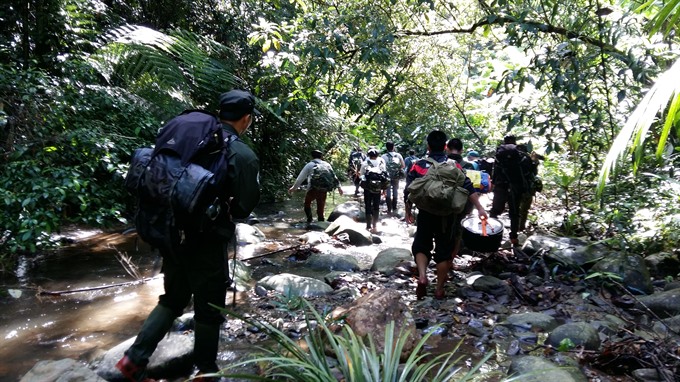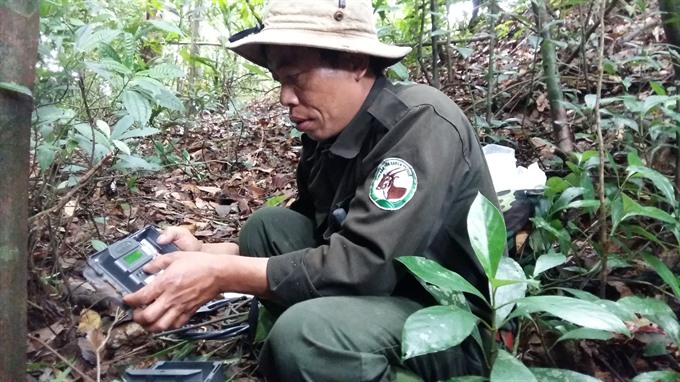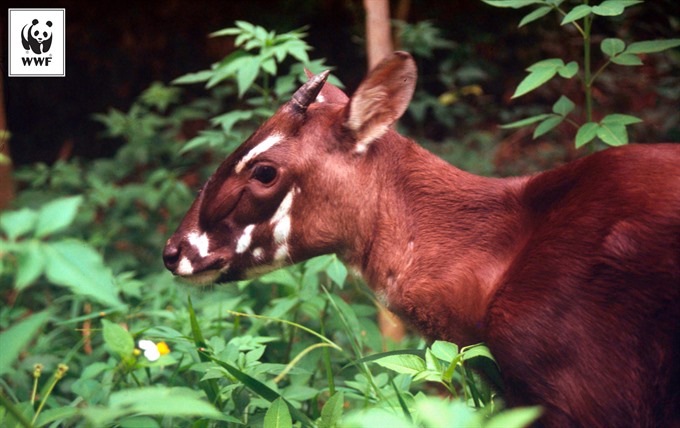.jpg) Society
Society
.jpg)
The Bạch Mã National Park has been selected as the site for the world’s only breeding centre for the saola, the extremely elusive forest-dwelling bovine only found in the forests of Việt Nam and Laos.
 |
| A team of rangers on patrol to track the saola in a forest in A Lưới District. — VNS Photo Công Thành |
THỪA THIÊN-HUẾ — The Bạch Mã National Park has been selected as the site for the world’s only breeding centre for the saola, the extremely elusive forest-dwelling bovine only found in the forests of Việt Nam and Laos.
The sao la is a critically endangered creature that was the eighth new large mammal species to be discovered in the 20th century.
The selection of the park in the central province of Thừa Thiên-Huế as the breeding site was made by the Ministry of Agriculture and Rural Development (MARD) in technical partnership with the Saola Working Group.
The centre is scheduled to be built by the end of this year or early next year, according to the World Wide Fund for Nature (WWF).
Information about the breeding centre was released on the occasion of the second World Saola Day, observed on July 9 every year.
A WWF statement said the centre “marks a renewed sense of hope and urgency for an international partnership to develop the first-ever conservation breeding programme for the saola, an antelope-like mammal so rare that no biologist has ever seen it in the wild.”
Also known as the Vũ Quang ox, spindlehorn, or Asian bicorn (Pseudoryx nghetinhensis), the saola is one of the world’s rarest large mammals found only in the Trường Sơn Mountain Range of Việt Nam and Laos.
 |
| A ranger sets up a camera trap for the saola and other forms of wildlife in a forest in A Lưới district, Thừa Thiên-Huế Province in snapping wildlife and saola. — VNS Photo Công Thành |
Although the partnership, coordinated by the Saola Working Group (SWG), has made significant advances in the protection of saola habitat in the Annamite mountain range on the border of Việt Nam and Laos, commercial poaching remains rampant, leaving the saola teetering on the edge of extinction.
“Time is running out for the saola,” said William Robichaud, co-ordinator of the Saola Working Group with the International Union for Conservation of Nature (IUCN) Species Survival Commission (SSC).
“A conservation breeding programme for a species as elusive as the saola certainly faces challenges, but inaction now poses an even greater risk to the survival of this remarkable animal. With the support and expertise of some of the world’s premier field conservation organisations, leading conservation-oriented zoos, and governments of both range countries, we are well-positioned to make a difference before it’s too late.”
Before bringing animals into the centre, however, the team will need to find them.
Since the species’ astounding discovery in 1992, only about 10 saola have ever been captured alive, all caught by local villagers in Laos and Việt Nam. Without professional veterinary and husbandry care, the longest that any of the animals lived was a few months. The last saola known to be captured alive was in 2010 in a village in Laos. It died in less than a week.
Biologists have also only photographed the species five times in the wild since its discovery 25 years ago, all by camera traps — twice in Laos and three times in Việt Nam.
The most recent camera trap photos were taken in 2013, when a WWF camera trap caught images of an animal in a saola nature reserve in central Việt Nam. It was the first photo of a saola in the wild in more than 15 years.
 |
| A saola ccaught on camera in central Laos (Bolikhamxay Province) in 1999. — Photo courtesy William Robichaud |
Saola are difficult to detect because of their elusiveness, which gives them the nickname Asian ‘unicorn,’ and because they live in dense forest in remote and difficult terrain.
“We are in a race against the clock to save the saola and it will take an all-out effort to ensure their survival—through captive breeding and increased enforcement efforts against poaching, wildlife trade and habitat destruction," said Văn Thịnh Ngọc, country director, WWF-Việt Nam.
"The few confirmed sightings of saola are a testament to the dedicated and tireless efforts of the forest guards. We hope one day that these guards will be rewarded with a growing, healthy saola population in the Central Annamites Species Recovery Landscape.”
SWG biologists and partners are currently testing several techniques to detect the saola, ranging from “tried-and-true” methods, like automated camera traps, to newer ones including environmental DNA.
Camera trap efforts in the saola’s range have provided invaluable information about other rare and endemic Annamite species in recent years, including the Annamite-striped rabbit and the critically endangered large-antlered muntjac, which is a species of barking deer.
Large and medium-sized mammals in the Annamites are threatened by intensive poaching, usually accomplished by the setting of wire snares. SWG and partners will also use the breeding centre to establish the first conservation programme for the large-antlered muntjac, which was discovered two years after the saola. This will be the first organised attempt to breed either species. — VNS
| The Saola Working Group works collaboratively to conserve saola in nature, and to leverage saola as a flagship for conservation of the bio-cultural diversity of the Annamite Mountains as a whole. The Saola Working Group is part of the IUCN Species Survival Commission’s Asian Wild Cattle Specialist Group. The SWG was formed in 2006 in recognition of the need for urgent, focused and coordinated action to save saola from extinction. |
.jpg)



